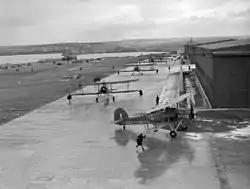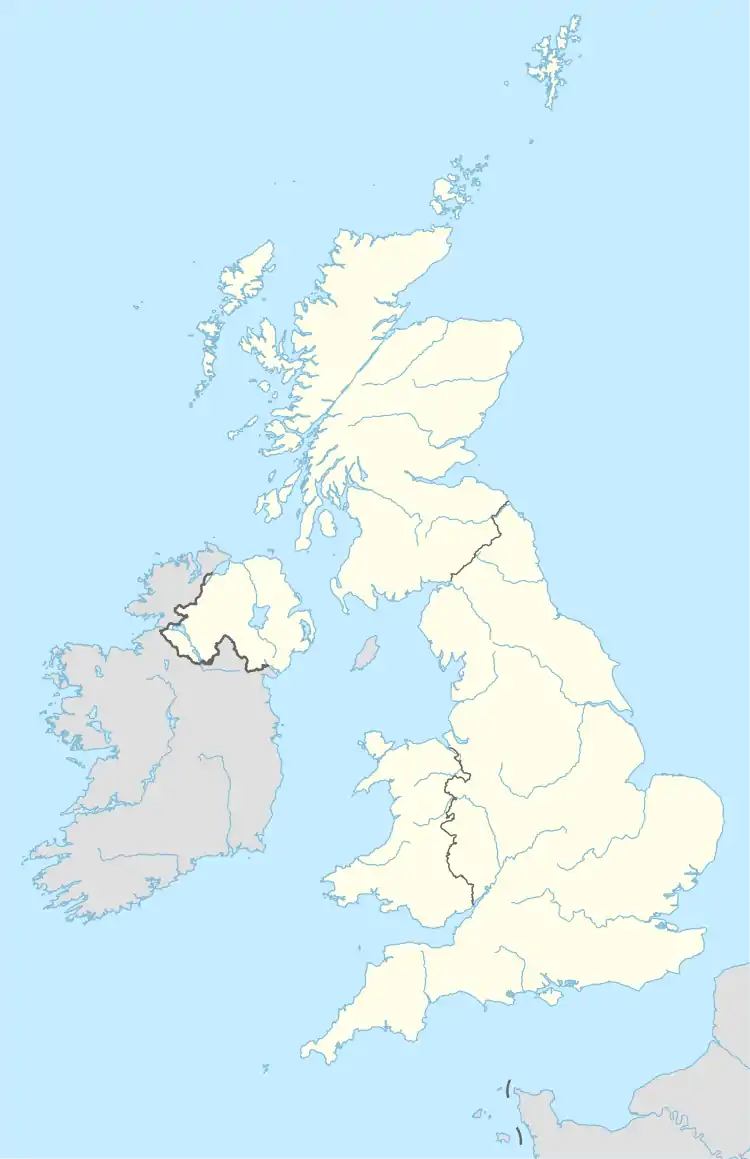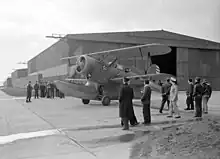| RNAS Hatston (HMS Sparrowhawk) | |||||||||||||
|---|---|---|---|---|---|---|---|---|---|---|---|---|---|
| Kirkwall, Mainland, Orkney in Scotland | |||||||||||||
 Fairey Swordfish taxi along the tarmac to take off for an exercise with dummy torpedoes from HMS Sparrowhawk, Royal Naval Air Station, Hatston. | |||||||||||||
 RNAS Hatston Shown within the Orkney Islands  RNAS Hatston RNAS Hatston (the United Kingdom) | |||||||||||||
| Coordinates | 58°59′39″N 002°58′35″W / 58.99417°N 2.97639°W | ||||||||||||
| Grid reference | HY435125 | ||||||||||||
| Type | Naval Air Station | ||||||||||||
| Code | H | ||||||||||||
| Site information | |||||||||||||
| Owner | Admiralty | ||||||||||||
| Operator | |||||||||||||
| Controlled by | Fleet Air Arm | ||||||||||||
| Condition | Disused | ||||||||||||
| Site history | |||||||||||||
| Built | 1934 | ||||||||||||
| In use | October 1939 - 1948 | ||||||||||||
| Fate | Closed | ||||||||||||
| Battles/wars | European theatre of World War II | ||||||||||||
| Airfield information | |||||||||||||
| Elevation | 7 metres (23 ft) AMSL | ||||||||||||
| |||||||||||||
Royal Naval Air Station Hatston (RNAS Hatston, also called HMS Sparrowhawk), was a Royal Naval Air Station, one mile to the north west of Kirkwall on the island of Mainland, Orkney, Scotland. It was located near the strategically vital naval base of Scapa Flow, which for most of the twentieth century formed the main base of the ships of the Home Fleet. The airbase was designed to provide accommodation for disembarked Front-Line squadrons and accommodation for disembarked Ship's Flight Aircraft and was home to the Home Fleet Fleet Requirements Unit, 771 Naval Air Squadron.
The airbase was situated near two notable landmarks, it was located next to the town and port of Kirkwall, with Scapa Flow 2.5 miles (4 km) south. The airfield was sited on the south bank of the Bay of Kirkwall, 1 mile (2 km) north east of the town of Kirkwall, and the road from Kirkwall to Finstown forms the southern boundary of the airfield.[1]
It was purpose built by the Admiralty and commissioned on 2 October 1939 as HMS Sparrowhawk, the airbase remained operational for almost six years, before It was ‘paid off’ on 1 August 1945. It immediately re-commissioned on the same day as HMS Tern II. Six weeks later it decommissioned for a second time, on 15 September and the airbase was reduced to care and maintenance.[1]
History
In 1939 an Admiralty representative sought the advice of Ted Fresson on the best site for an airfield in Orkney. Fresson, the founder of Highland Airways and now working for Scottish Airways, recommended the site at Hatston. Fresson had earlier wanted to create an airfield there, but the land owner had refused him. Fresson warned that the location would become very muddy and unsuitable for modern aircraft, and recommended that asphalt runways be built.[2] Thus once the airfield was established later that year, it was probably the first in Britain to have hard runways.[3] The airfield was declared operational in early 1940.[4]
During the Second World War, it was host to a number of different types of aircraft of the Fleet Air Arm, including Fairey Swordfish, Blackburn Rocs, Grumman Martlet IV and Grumman Avengers. Two squadrons of Blackburn Skuas flew from Hatston on 10 April 1940, on a mission to sink the German cruiser Königsberg, in which they were successful.

From April 1942 a number of United States Navy squadrons operated out of RNAS Hatston, the airbase being used by American aircraft including Douglas TBD Devastator, an American torpedo bomber, Grumman F4F Wildcat, an American carrier-based fighter aircraft and Vought SB2U Vindicator, an American carrier-based dive bomber.[5]
After the war, Hatston became Kirkwall's main civil airport and was served by Allied Airways and Scottish Airways, which were both absorbed by British European Airways (BEA) in 1947. By 1948 BEA was operating Douglas Dakotas which were deemed too large to use the runways safely. They moved operations to a larger airfield, RAF Grimsetter, 3 miles (4.8 km) south-east of Kirkwall. RNAS Hatston was officially closed in 1948, but from 1953 until 1957 was the home of the Orkney Flying Club.[5]
Finally it was closed and turned into an industrial estate, with some buildings becoming council housing.[6] Several local street names commemorate the airfield, including Sparrowhawk Road, Seafire Road, Swordfish Road, Skua Road, Dakota Road and Gladiator Road.
Second World War
During the Second World War large numbers of various front line Fleet Air Arm squadrons and their associated aircraft used RNAS Hatston for short periods of time after disembarking from Royal Navy aircraft carriers before they anchored in Scapa Flow. Two Fleet Air Arm units did have a more permanent presence at the airbase. 700 Naval Air Squadron (700 NAS), which provided final training for catapult aircraft aircrew before they embarked on their assigned ships, formed at the airbase in 1940 remaining until moving the short distance to nearby RNAS Twatt (HMS Tern) during 1942. 771 Naval Air Squadron (771 NAS), a Fleet Requirements Unit (FRU), was based at RNAS Hatston from 1939, relocating around the same time as 700 NAS to RNAS Twatt, in 1942. It operated a number of different aircraft types, undertaking various tasks, supporting the Home Fleet at Scapa Flow.[5]
Units
The following units were here at some point:[7]
- 700 NAS, 701 NAS, 712 NAS, 746 NAS, 771 NAS
- 800 NAS, 801 NAS, 802 NAS, 803 NAS, 804 NAS, 806 NAS, 807 NAS, 809 NAS,
- 810 NAS, 811 NAS, 812 NAS, 813 NAS, 814 NAS, 816 NAS, 817 NAS, 818 NAS, 819 NAS,
- 820 NAS, 821 NAS, 822 NAS, 823 NAS, 824 NAS, 825 NAS, 826 NAS, 827 NAS, 828 NAS, 829 NAS,
- 830 NAS, 831 NAS, 832 NAS, 833 NAS, 835 NAS, 836M Flight, 837 NAS, 837D Flight,
- 840 NAS, 841 NAS, 842 NAS, 845 NAS, 846 NAS, 848 NAS, 852 NAS, 853 NAS, 856 NAS,
- 860 NAS, 878 NAS, 880 NAS, 881 NAS, 882 NAS, 883 NAS, 884 NAS, 885 NAS, 887 NAS, 888 NAS,
- 890 NAS, 891 NAS, 893 NAS, 894 NAS, 896 NAS, 898 NAS, 899 NAS,
- 1770 NAS, 1771 NAS,
- 1820 NAS, 1840 NAS, 1841 NAS, 1842 NAS,
- No. 254 Squadron RAF[8]
References
Citations
- 1 2 "R.N.A.S. Hatston". Royal Navy Research Archive - Fleet Air Arm Bases 1939 - present day. Retrieved 22 November 2023.
- ↑ Warner 2005, p. 27.
- ↑ Smith 1989, p. 114.
- ↑ Warner 2005, p. 24.
- 1 2 3 "Hatston (Kirkwall)". Airfields of Britain Conservation Trust. Retrieved 22 November 2023.
- ↑ Smith 1989, p. 115.
- ↑ Sturtivant & Ballance 1994.
- ↑ Jefford 1988, p. 81.
Bibliography
- Delve, Ken (2010). The Military Airfields of Britain Scotland and Northern Ireland. Marlborough, Wiltshire UK: The Crowood Press Ltd. ISBN 978-1-84797-027-5.
- Jefford, C. G. (1988). RAF Squadrons. A comprehensive record of the movement and equipment of all RAF squadrons and their antecedents since 1912. Shrewsbury: Airlife. ISBN 1-85310-053-6.
- Smith, David J. (1989). Action Stations 7: Military Airfields of Scotland, the North-East and Northern Ireland (2nd ed.). Wellingborough, UK: Patrick Stephens Ltd. ISBN 1-85260-309-7.
- Sturtivant, R; Ballance, T (1994). The Squadrons of The Fleet Air Arm. Tonbridge, Kent, UK: Air-Britain (Historians) Ltd. ISBN 0-85130-223-8.
- Warner, Guy (2005). Orkney by Air. Erskine, Scotland: kea publishing. ISBN 0951895877. Retrieved 28 April 2023.